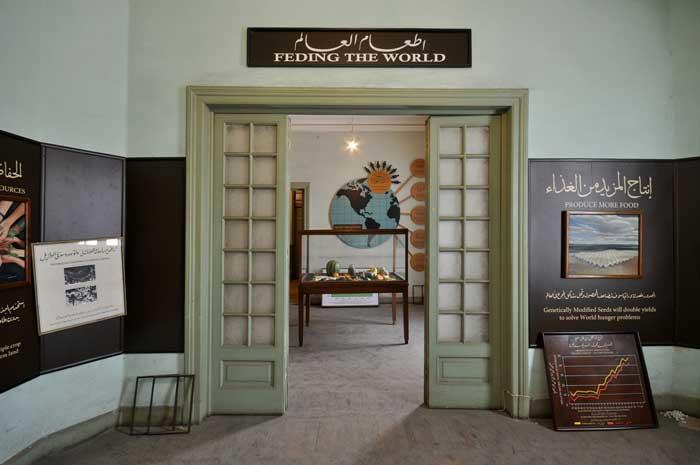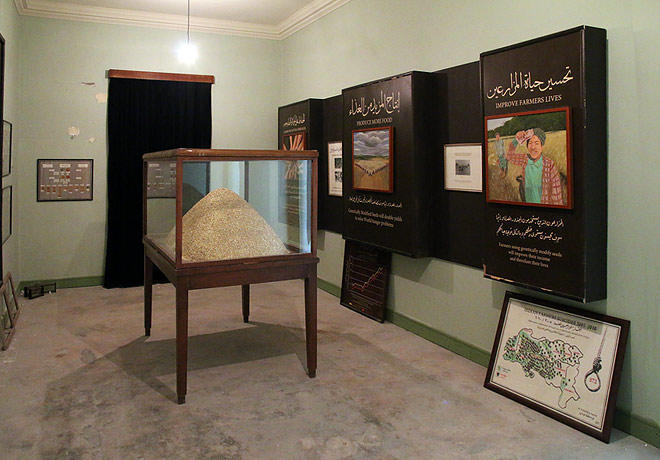
Cairo
Asunción Molinos Gordo: World Agricultural Museum, Part 1
The Townhouse Gallery
December 13, 2010–May 15, 2011
Asunción Molinos Gordo’s exhibition Untitled 3 WAM (World Agriculture Museum) was originally slated to last one and a half months. Originally scheduled to close on January 31, 2011, the show was extended due to the events in and around January 25th. Four-plus months is a biblical lifespan for any exhibition, more so when it bridges the collapse of an autocratic political regime that held sway for thirty years — a lifetime for the majority of the country’s youthful population. In a way, the exhibition’s hyperbolic duration complemented its ruse of mimicking Cairo’s historic Agricultural Museum, or al-mathaf al-zara‘i. By mid-May, when it finally closed, the exhibition had acquired an air of abandoned, musty permanence that uncannily echoed the effect of the decades-long neglect on so many public sector institutions in Egypt, especially the Agricultural Museum.
Paradoxically, this progressive disregard over the past forty-some years has preserved as if in amber a long-outdated language of museum display and the rhetoric of statehood it implicated. Molinos Gordo went to great lengths to locate and assemble a team of local specialists capable of executing a near-perfect simulacrum of the original museum’s visual language. Visitors to WAM encountered elegant wood and glass vitrines populated with plaster models of fruits and vegetables. Confident Arabic calligraphy and painstaking English-language lettering adorned wall-mounted scientific displays; signed oil paintings depicted the banal processes of agricultural production; a quaint diorama sat recessed behind glass; and dusty, hand-labeled specimens were arranged in neat rows. Piles of mothballs in the corners lent the exhibition a sometime overwhelming olfactory dimension.
The strategy of imitation extended to the site of the exhibition. Located in an empty flat one story below the traditional white-cube gallery of the Contemporary Image Collective in downtown Cairo, WAM remained relatively inconspicuous as a contemporary art space. A placard in Arabic and English outside the door simulated the look of an office sign displayed beside a neighboring apartment. And so for months the pseudo-museum seemed to lie motionless inside that decaying apartment building, like some predatory insect disguising itself as a twig as, nearby, Midan Tahrir filled and emptied.
Yet the artist claims that issues of reproduction and disguise, and indeed the institutional specificities of Cairo’s Agricultural Museum were peripheral to her intentions. WAM was conceived, rather, as a vehicle for publicizing the negative impact of genetically modified organisms, or GMOs. The original Agricultural Museum simply supplied the artist with an accessible, multimedia mode of visual display capable of communicating complex agriculture-related issues to a diverse public.

As the visitor moved through the suite of rooms comprising the exhibition, they encountered one talking point after another concerning the already realized catastrophes, ill-founded logic, and future dangers attending the use of GMOs in food crops. One room, addressed arguments regarding the relationship of GMOs to world hunger, while another spoke to intellectual property rights issues. Together, these formed a “collage” of arguments rendered in broad strokes rather than as a careful progression or dialectic. The exhibition ended, however, unequivocally, with a diorama depicting the Svalbard Global Seed Vault near the North Pole, built to guard seed diversity against various doomsday contingencies, and a wall-sized presentation on “Crops Diversity Hazards” (sic) featuring oil paintings of a volcano erupting, the earth roasting over what appeared to be a wood-burning fire, and a bomb exploding in a field, representing, respectively, natural disasters, global warming and war.
Where once institutions such as the Agricultural Museum presented agricultural issues as worthy of aesthetic contemplation, the field’s increasing industrialization and privatization both locally and internationally seems to have removed it from the sphere of public debate and certainly pleasurable reflection. WAM’s mapping of an outdated museum display onto contemporary trends in the field of agriculture brought this historic shift into relief. However, the generally straightforward transliteration of an argument concerning international social justice and environmental concerns into the highly specific visual language of Cairo’s Agricultural Museum seemed overwrought at times, and threatened to reduce the richness of the latter to the diagnostic matter-of-factness claimed by the former. Molinos Gordo insists on the primacy of her argument, even at the expense of the other possible readings of the exhibition. Yet the argument itself hangs together loosely, relying on a rich visual presentation interspersed with statistics and snippets of official reports rather than making a closely reasoned case.
Occasionally, as if in rebellion, an element of the display appeared to move beyond the purposes of an instrumentalized simulacrum to assert its presence as an individual work of art. In the first room, a small mountain of gold-painted grains of rice occupied a wooden vitrine the size of a large fish tank. Entering another space, the viewer confronted a sprouting fava bean, that staple of the Egyptian diet, in the form of a large painted plaster model, as artificial and oddly beautiful as a rare orchid in a greenhouse.
The most interesting aspects of the exhibition lingered as afterthoughts. A certain absurdity clings to the gesture of recreating, with great labor and painstaking precision, a language of visual display that seems otherwise suspended in time, with the Agricultural Museum posing as the forgotten core of the famously chaotic city swirling around it. What does it mean, after all, to commission a seventeen-person team to reproduce a slice of the country’s museological subconscious? The work of putting together such a team is itself an interesting proposition, and the profiles of those ultimately involved in the production lend some insight into a backdrop of artistic production harnessed by the exhibition.
The artist conducted interviews before ultimately hiring individuals to produce WAM’s displays. The majority of the candidates were young. Many were graduates of the city’s fine arts colleges; others were self-taught or apprenticed. A skilled calligrapher was difficult to locate due to the drop-off in numbers of new students training in this field. Candidates tended to discuss their practices in highly technical rather than conceptual terms. According to Molinos Gordo, many complained of a lack of basic resources such as studio space and materials. Some aimed to solicit the patronage of a gallery that would help sell their work and provide material support for their practices, while others looked to a diverse array of commercial commissions for income.
The stasis afforded by the exhibition’s extended runtime provided the saliency of the artist’s GMO argument some time to decay, and allowed the maturation of other resonant political and social concerns in its place. Understood in a manner tangential to the original intentions of the artist, the exhibition seemed directed at the deterioration of the institutions that constitute Egypt’s moldering public sector, within which the cultural sector remains firmly rooted: a counterpoint to the rampant, often illegitimate privatization initiatives undertaken by members of the former president’s government. Some of the skills and knowledge base that helped sustain this sector for decades have faded, while others remain foundations of art practice and instruction. The latter retain a certain currency that crosses so-called commercial and fine art sectors, yet often without being able to claim much purchase outside the narrowly defined networks of individuals and institutions invested in promoting and extending their relevance.
WAM is perhaps most interesting as a comment on the field of contemporary art in Egypt, a field conceived long ago as one element within a state-sponsored public sphere, which has subsequently suffered a profound neglect with major implications for those individuals and institutions operating within it. In some ways, today’s practices seem devoted to the replication of artistic languages adopted years ago in relation to a very different set of political, ideological, and aesthetic concerns. It seems increasingly relevant, then, to ask the question inadvertently set in motion by WAM: what does it mean to reproduce the terms of a visual language established long ago, and for other ends?